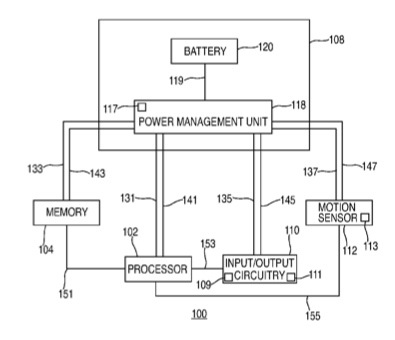Apple is eyeing ways of using motion detection in iOS devices to further extend battery life. A company patent (number 7,873,749) for motion sensor data processing using various power has appeared at the US Patent & Trademark Office.
Per the patent, power may be provided to a motion sensor during a first power mode of the device. In response to the motion sensor detecting a motion event with a magnitude exceeding a threshold, the sensor may transmit a wake up signal to a power management unit of the device. In response to receiving the wake up signal, the power management unit may switch the device to a second power mode.
The device may provide power to a processor and load the processor with a motion sensing application when switching to the second power mode. During the second power mode, motion sensor data may be processed to determine that the motion event is not associated with an intentional user input and the device may return to the first power mode. The inventors are Andrea Mucignat and Saurabh Gupta.
Here’s Apple’s background and summary of the invention: “Electronic devices, and in particular portable electronic devices (e.g., portable media players and cellular telephones), often include one or more sensors for detecting characteristics of the device and its surroundings. For example, an electronic device may include one or more motion sensors, such as an accelerometer or gyroscope, for detecting the orientation and/or movement of the device.
“The electronic device may process the data generated by the motion sensors and may be operative to perform particular operations based on the processed motion sensor data. For example, an electronic device may process motion sensor data to determine the number of steps taken by a user carrying the device, thereby providing a pedometer application. This type of pedometer application may be utilized by the device over a long period of time in order to detect every step taken by a user, even when the user may not be actively interacting with the device. However, keeping certain device components active during utilization of such a pedometer application may consume a significant amount of the power available to the device.
“Systems, methods, and computer-readable media for processing motion sensor data using various power management modes of an electronic device are provided. For example, in some embodiments, there is provided a method for controlling power consumption of an electronic device. The method may include providing power to a motion sensor of the device during a first inactive power mode of the device.
“Next, the method may include switching from the first inactive power mode to a first active power mode of the device in response to detecting a magnitude of a motion event that exceeds a threshold using the motion sensor. After the switching, the method may include returning from the first active power mode to the first inactive power mode in response to determining that the motion event is not associated with an intentional user input.
“For example, the switching may include activating at least a portion of a processor of the device and loading the processor with a motion sensing application. The switching may also include instructing the processor to bypass a device component activation step of the application, such as a device component activation step that instructs the processor to at least partially activate a display output component of the device. The returning may include unloading the motion sensing application from the processor and deactivating at least a portion of the processor.
“In other embodiments, there is provided a method for controlling power consumption of an electronic device. The method may include processing first motion sensor data for a first duration of time during a first active power mode of the device. Next, the method may include switching from the first active power mode to a first inactive power mode of the device in response to detecting that the first processed motion sensor data identifies a first motion event occurring a first number of times during the first duration of time at a first rate.
“Then, the method may include returning from the first inactive power mode to the first active power mode after a second duration of time. Next, the method may include processing second motion sensor data for a third duration of time and determining that the second processed motion sensor data identifies the first motion event occurring a second number of times during the third duration of time at the first rate. Finally, the method may include responding to a third number of the first motion event. The third number may equal the second number plus the product of the second duration of time and the rate.
“For example, the second duration of time may be longer than the third duration of time. In some embodiments, the first motion event may be a user stepping event and the method may include storing the third number in a counter indicative of the amount of steps taken by a user of the device. In some embodiments, the switching from the first active power mode to the first inactive power mode may include unloading a motion sensing application from a processor of the device and deactivating at least a portion of the processor.”
— Dennis Sellers
dsellers@applecentral.com


